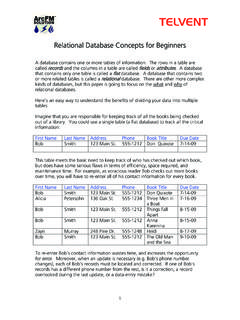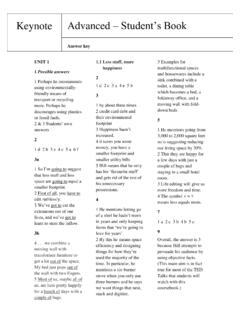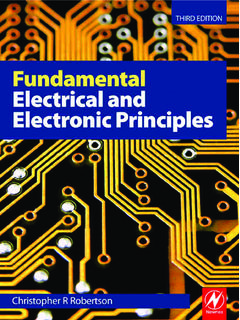Transcription of Question paper (Higher) : Paper 2 - Sample set 1
1 SPECIMEN MATERIAL SPECIMEN MATERIAL GCSE PHYSICS Higher Tier Paper 2H Specimen 2018 Time allowed: 1 hour 45 minutes Materials For this Paper you must have: a ruler a calculator a protractor the Physics Equation sheet (enclosed). Instructions Answer all questions in the spaces provided. Do all rough work in this book. Cross through any work you do not want to be marked. Information There are 100 marks available on this Paper . The marks for questions are shown in brackets. You are expected to use a calculator where appropriate. You are reminded of the need for good English and clear presentation in your answers. When answering questions , , and you need to make sure that your answer: is clear, logical, sensibly structured fully meets the requirements of the Question shows that each separate point or step supports the overall answer. Advice In all calculations, show clearly how you work out your answer.
2 HPlease write clearly, in block capitals. Centre number Candidate number Surname Forename(s) Candidate signature 2 SPECIMEN MATERIAL A student suspended a spring from a laboratory stand and then hung a weight from the spring. Figure 1 shows the spring before and after the weight is added. Figure 1 Measure the extension of the spring shown in Figure 1. [1 mark] Extension =mm 0 1 . 1 0 1 3 SPECIMEN MATERIAL Turn over The student used the spring, a set of weights and a ruler to investigate how the extension of the spring depended on the weight hanging from the spring. Before starting the investigation the student wrote the following prediction: The extension of the spring will be directly proportional to the weight hanging from the spring. Figure 2 shows how the student arranged the apparatus.
3 Figure 2 Before taking any measurements, the student adjusted the ruler to make it vertical. Explain why adjusting the ruler was important. [2 marks] Question 1 continues on the next page 0 1 . 2 4 SPECIMEN MATERIAL The student measured the extension of the spring using a range of weights. The student s data is shown plotted as a graph in Figure 3. Figure 3 What range of weight did the student use? [1 mark] Why does the data plotted in Figure 3 support the student s prediction? [1 mark] Describe one technique that you could have used to improve the accuracy of the measurements taken by the student. [2 marks] 0 1 . 3 0 1 . 4 0 1 . 5 5 SPECIMEN MATERIAL Turn over The student continued the investigation by increasing the range of weights added to the spring. All of the data is shown plotted as a graph in Figure 4. Figure 4 At the end of the investigation, all of the weights were removed from the spring.
4 What can you conclude from Figure 4 about the deformation of the spring? [2 marks] Give the reason for your conclusion. 0 1 . 6 6 SPECIMEN MATERIAL In 1929, the astronomer Edwin Hubble observed that the light from galaxies moving away from the Earth had longer wavelengths than expected. What name is given to this effect? [1 mark] From his observations, Hubble was able to calculate the speed of a galaxy and the distance of the galaxy from the Earth. Figure 5 shows the results of Hubble s calculations. Figure 5 What relationship between the speed of a galaxy and the distance is suggested by Hubble s results? [1 mark] 0 2 0 2 . 1 0 2 . 2 7 SPECIMEN MATERIAL Turn over The observations made by Hubble support the idea that the Universe is expanding. This means that galaxies are continually moving away from each other and from the Earth. Figure 6 shows a student using a balloon to model the idea of an expanding Universe.
5 Some dots, which represent galaxies, were marked on the balloon. The balloon was then inflated. Figure 6 Give one strength and one weakness of this model in representing the idea of an expanding Universe. [2 marks] strength weakness 0 2 . 3 8 SPECIMEN MATERIAL In the 1950s there were two main theories to explain how the Universe began. The Universe has always existed, it is continually expanding. New galaxies are formed as older galaxies die out. The Universe began from a very small region that was extremely hot and dense. The Universe has been expanding ever since. In what way do the observations made by Hubble support both Theory 1 and Theory 2? [1 mark] Most scientists now believe that Theory 2 is correct. Suggest what is likely to have caused scientists to start thinking Theory 1 is wrong. [1 mark] 0 2 . 4 0 2 . 5 Theory 1 Theory 2 9 SPECIMEN MATERIAL Turn over A student investigated how the magnification produced by a convex lens varies with the distance (d) between the object and the lens.
6 The student used the apparatus shown in Figure 7. Figure 7 The student measured the magnification produced by the lens by measuring the image height in centimetres. Explain why the image height in centimetres was the same as the magnification. [2 marks] 0 3 0 3 . 1 10 SPECIMEN MATERIAL The data recorded by the student is given in Table 1. Table 1 Distance between the object and the lens in cm Magnification25 30 40 50 60 It would be difficult to obtain accurate magnification values for distances greater than 60 cm.
7 Suggest one change that could be made so that accurate magnification values could be obtained for distances greater than 60 cm. [1 mark] 0 3 . 2 11 SPECIMEN MATERIAL Turn over The graph in Figure 8 is incomplete. Figure 8 Complete the graph in Figure 8 by plotting the missing data and then drawing a line of best fit. [2 marks] How many times bigger is the image when the object is 35cm from the lens compared to when the object is 55 cm from the lens? [2 marks] Question 3 continues on the next page 0 3 . 3 0 3 . 4 12 SPECIMEN MATERIAL During the investigation the student also measured the distance between the lens and the image. Table 2 gives both of the distances measured and the magnification. Table 2 Distance between the lens and the image in cm Distance between the lens and the object in cm Magnification 100 25 60 30 40 40 33 50 30
8 60 Consider the data in Table 2. Give a second way that the student could have determined the magnification of the object. Justify your answer with a calculation. [2 marks] 0 3 . 5 13 SPECIMEN MATERIAL Turn over Complete the ray diagram in Figure 9 to show how the convex lens produces the image of a close object. Use an arrow to represent the image. [3 marks] Figure 9 Turn over for the next Question 0 3 . 6 14 SPECIMEN MATERIAL Figure 10 shows a straight wire passing through a piece of card. A current (I) is passing down through the wire. Figure 10 Describe how you could show that a magnetic field has been produced around the wire. [2 marks] 0 4 0 4.
9 1 15 SPECIMEN MATERIAL Turn over Figure 11 shows the ignition circuit used to switch the starter motor in a car on. The circuit includes an electromagnetic switch. Figure 11 Explain how the ignition circuit works. [4 marks] 0 4 . 2 16 SPECIMEN MATERIAL The data given in Table 3 was obtained from an investigation into the refraction of light at an air to glass boundary. Table 3 Angle of incidenceAngle of refraction20 13 30 19 40 25 50 30 Describe an investigation a student could complete in order to obtain similar data to that given in Table 3. Your answer should consider any cause of inaccuracy in the data. A labelled diagram may be drawn as part of your answer. [6 marks] 0 5 0 5 . 1 17 SPECIMEN MATERIAL Turn over State the reason why light is refracted as it crosses from air into glass. [1 mark] Turn over for the next Question 0 5.
10 2 18 SPECIMEN MATERIAL Figure 12 shows the construction of a simple transformer. Figure 12 Why is iron a suitable material for the core of a transformer? [1 mark] Tick one box. It is a metal. It will not get hot. It is easily magnetised. It is an electrical conductor. 0 6 . 1 0 6 19 SPECIMEN MATERIAL Turn over A student makes three simple transformers , J, K and L. Figure 13 shows how the potential difference across the secondary coil of each transformer varies as the potential difference across the primary coil of each transformer is changed. Figure 13 How can you tell that transformer J is a step-down transformer? [1 mark] Each of the transformers has 50 turns on the primary coil. Calculate the number of turns on the secondary coil of transformer L. Use the correct equation from the Physics Equations Sheet. [3 marks] Number of turns on the secondary coil = 0 6.















